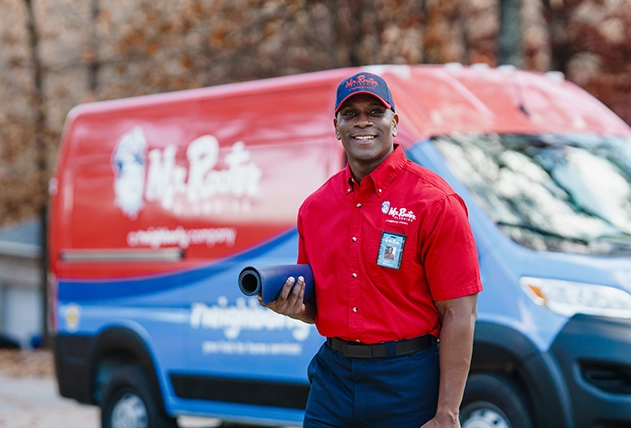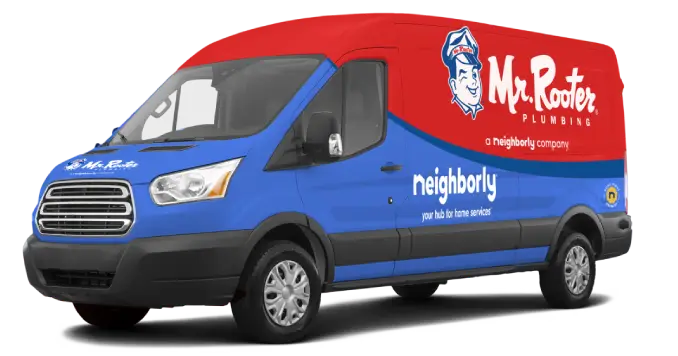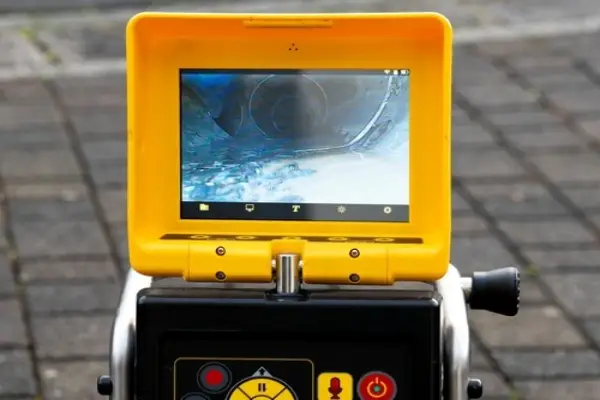
|
Trenchless pipe bursting is a trenchless sewer line replacement method that avoids full excavation. A bursting head breaks apart the old pipe through small access pits while pulling a new, durable pipe into place—restoring your line quickly with minimal property damage. |
Mr. Rooter Plumbing® experts explain that trenchless pipe bursting offers a modern, less invasive solution to sewer line replacement. Key insights include:
|
In the past, a failed sewer line might mean a torn-up yard, broken driveway, and weeks of disruption. Trenchless pipe bursting offers a smarter approach. Using just two access points, this method breaks apart the old pipe while installing a durable replacement. The result is faster, cleaner, and far less invasive than traditional excavation.
In this article, we’ll break down the process of trenchless pipe bursting, how it works, and when it may be the right solution for your property.
What Is Trenchless Pipe Bursting?
Trenchless pipe bursting is a modern way to replace underground sewer lines without tearing up your entire yard. Instead of digging a long trench, a tool called a bursting head is pulled through the old pipe. As it moves forward, it breaks the damaged line apart and draws a new pipe—often high-density polyethylene (HDPE)—into the same space.
The process is “trenchless” because it only requires two access points, called pits: one at the beginning of the line and one at the end. This results in much less disruption to landscaping, driveways, or sidewalks compared to traditional excavation and sewer line repair.
Homeowners and property managers often turn to trenchless pipe bursting when:
- A pipe has collapsed, cracked, or shifted too much to be relined.
- Severe tree root damage has made the lining ineffective.
- A larger pipe is needed to improve flow.
In short, trenchless pipe bursting replaces a failing sewer line quickly, cleanly, and with minimal surface damage, providing a smarter alternative to digging.
How Does Trenchless Pipe Bursting Work?
While the concept sounds advanced, the process is straightforward when handled by trained plumbing service professionals. The method uses specialized trenchless pipe bursting equipment, including a bursting head, cables, and hydraulic systems, to break apart the old pipe and pull in the new one.
Here’s what typically happens during a trenchless pipe bursting service:
- Inspection: A camera is used to inspect the existing line and confirm that bursting is the best option.
- Access pits: Two pits are dug—one at the start of the line and one at the end. Pit diameter varies depending on the size and depth of the pipe, but 2.5–3 times the pipe depth is a typical rule of thumb.
- Bursting head insertion: A specialized tool, called a bursting head or expander, is pulled through the old pipe.
- Breaking and replacement: As it moves forward, the bursting head fractures the old pipe and immediately pulls a new high-density polyethylene (HDPE) pipe into place.
- Reconnection: Service laterals and fixtures are reconnected to the new pipe, restoring full function to the system.
For most residential properties, the entire process can often be completed in a single day. Because it requires minimal digging, cleanup and restoration are much faster than with traditional excavation.
Pipe Bursting vs. Pipe Lining
Trenchless technology offers two main approaches: pipe bursting and pipe lining (also called cured-in-place pipe, or CIPP). Both avoid the mess of open-trench excavation, but they’re designed for different situations.
Pipe bursting
- Best for: Collapsed, broken, or undersized sewer lines where full replacement is needed.
- How it works: A bursting head fractures the old pipe while pulling a new HDPE pipe into its place.
- Pros: Fully replaces the old pipe, can increase pipe diameter, and provides a long service life with minimal digging.
- Cons: Requires two access pits; not suitable for asbestos-cement lines; may involve extra work to reconnect laterals.
Pipe Lining (CIPP)
- Best for: Leaking or cracked pipes that are still structurally intact.
- How it works: A resin-soaked liner is inserted into the old pipe and cured to form a new interior surface.
- Pros: Minimal digging; smooth pipe interior; effective at sealing leaks.
- Cons: Cannot upsize the line; host pipe must hold its shape; lifespan depends on existing conditions.
Less common methods, such as pipe splitting, may also be used depending on the condition of the existing line.
In short, trenchless pipe bursting is typically the better option when a pipe is beyond repair or needs upsizing, while pipe lining is a good choice if the existing pipe is still mostly sound.
Benefits of Trenchless Pipe Bursting
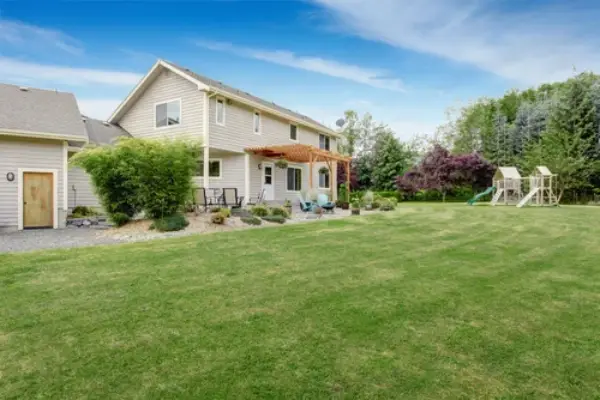
Trenchless pipe bursting is designed to solve major sewer line problems without creating new ones on the surface. Compared to traditional excavation, it offers clear advantages for homeowners and property managers:
- Less property disruption: Only two access pits are needed, so your yard, driveway, and landscaping remain largely untouched.
- Quicker turnaround: Many residential projects can be finished in a day, getting your system back up and running faster.
- Durable materials: The new pipe, typically high-density polyethylene (HDPE), resists corrosion, leaks, and tree root intrusion.
- Ability to upsize: If your old line was undersized, bursting allows for a larger replacement pipe, improving flow.
- Lower overall restoration costs: With minimal surface damage, there’s less need for expensive landscaping or hardscaping repairs afterward.
These benefits make trenchless pipe bursting a very popular option for homeowners and one of the most effective forms of trenchless sewer line replacement.
Pro Tip: While this article focuses on pipe bursting, it’s worth noting that other trenchless sewer repair methods offer their own advantages. Consult a local plumbing professional to learn more about these techniques.
Limitations and Considerations
Trenchless pipe bursting has clear advantages, but like any method, additional factors may affect its practicality for certain properties. Knowing these ahead of time helps set realistic expectations:
- Access points: The method requires two entry pits, typically several feet in diameter for residential applications. This may be challenging in very tight spaces or areas with limited clearance.
- Soil conditions: Loose, sandy, or rocky ground can make the process more complex and may require additional steps.
- Pipe type restrictions: Some older materials, such as asbestos-cement (A/C) pipes, cannot be burst safely and may require a different approach.
- Service lateral connections: Smaller branch lines that feed into the main line often need to be reconnected after the new pipe is installed.
- Nearby utilities: If other underground lines (gas, water, or electrical) run close to the sewer, extra planning and coordination are necessary.
These limitations don’t rule out pipe bursting, but they highlight why a professional inspection is essential. Every property has unique conditions, and understanding those details is the first step toward choosing the right solution.
How do you know if trenchless sewer repair is the best option for your home? Let’s look at the situations where it makes the most sense.
Is Trenchless Pipe Bursting Right For You?
Trenchless pipe bursting isn’t the answer for every plumbing issue, but it’s often the right choice for homeowners considering trenchless sewer line replacement. You may be a good candidate if:
- The pipe has collapsed or lost its shape: Lining won’t work if the structure is gone.
- Tree root intrusion is severe: Bursting fully replaces the line instead of sealing over damage.
- Your current line is too small: Bursting allows for a larger pipe to improve flow.
- You want to protect your property: Minimal digging helps preserve landscaping, driveways, and patios.
- You’re looking for long-term reliability: HDPE replacement pipe resists corrosion and root intrusion for decades.
If your pipe is still structurally sound but only leaking or cracked, pipe lining (CIPP) may be the better fit.
The best way to know for sure is through a professional sewer line inspection. A plumbing service professional can evaluate your pipe(s), walk you through the options, and recommend whether pipe bursting—or another trenchless method—makes the most sense.
Work With a Trusted Plumbing Professional
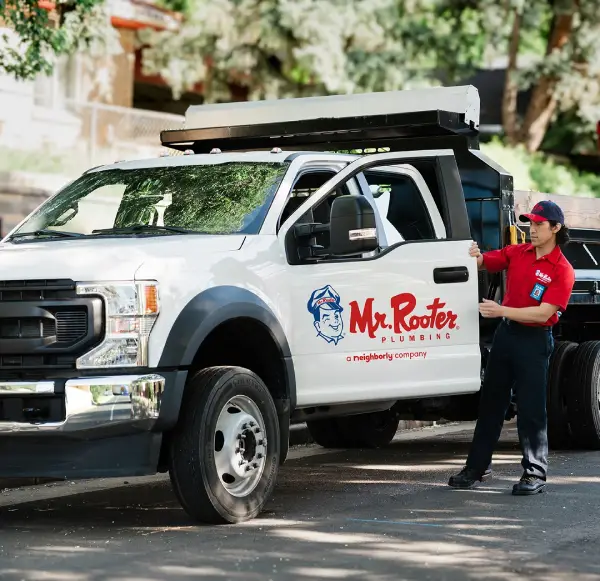
Trenchless sewer repair solutions like pipe bursting are best left to experienced service professionals. Every property is different, and factors like soil conditions, pipe materials, and nearby utilities can determine the right approach. That’s why an inspection matters—and why DIY sewer repair is never the right call.
A Mr. Rooter Plumbing® professional will evaluate your system, explain your options, and recommend the solution that restores your sewer line with as little disruption as possible. And with the Neighborly Done Right Promise®, you can count on work that meets your satisfaction.
Want to learn more? Explore our trenchless sewer line repair & replacement services or contact your local Mr. Rooter team to schedule an inspection.
This article is intended for general informational purposes only and may not be applicable to every situation. You are responsible for determining the proper course of action for your home and property. Mr. Rooter Plumbing is not responsible for any damages that occur as a result of this blog content or your actions. For the most accurate guidance, contact your local Mr. Rooter Plumbing location for a comprehensive, on-site assessment.
FAQs About Trenchless Pipe Bursting
What pipes can be replaced with trenchless pipe bursting?
Trenchless pipe bursting can replace many common sewer line materials, including clay, cast iron, concrete, and certain plastics. It’s often chosen as a trenchless sewer line replacement when the existing pipe is too damaged for relining.
A professional inspection will confirm whether pipe bursting will work for your situation.
How long does trenchless pipe bursting take?
Most residential trenchless pipe bursting projects can be finished in a single day. The process utilizes specialized equipment to break apart the old pipe while pulling a new one into place at the same time, providing an efficient solution.
Is trenchless pipe bursting safe for my yard and property?
Trenchless pipe bursting is typically safe for residential and commercial properties. Unlike open-trench digging, trenchless sewer repair methods require minimal digging or disruption to surrounding landscaping or pavement. While there may be concerns about nearby utility lines, these can be addressed on a case-by-case basis.
Is the replacement sewer line durable?
Yes! Pipes installed using trenchless pipe bursting are usually made of high-density polyethylene (HDPE). This material resists corrosion, root intrusion, and leaks.
With proper installation, an HDPE line from a trenchless sewer line replacement can last for decades.
How much does trenchless pipe bursting cost?
The cost of repiping via pipe bursting varies depending on the depth and length of the pipe, soil conditions, and property access. Because no two jobs are alike, the best way to get an accurate estimate is to schedule an inspection by a local Mr. Rooter professional.
